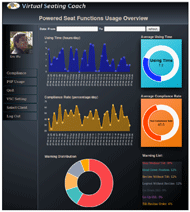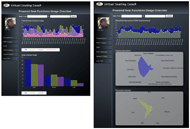A Prototype website for providing powered seat functions usage collected from Smartphone virtual seating coach
Yu-Kuang Wu, MS PT1,2, Hsin-Yi Liu, MS PT1,2, Annmarie Kelleher, MS OTR/L1,2, Rory A. Cooper, PhD1,2
1Department of Rehabilitation Sciences and Technology, School of Health and Rehabilitation Sciences, University of Pittsburgh
2Human Engineering Research Laboratories, Department of Veterans Affairs Pittsburgh Healthcare System
Pittsburgh, PA, USA
ABSTRACT
The Smartphone Virtual Seating Coach (SVSC) is a system that facilitates powered wheelchair users to utilize their PSFs (powered seat functions) based on clinical recommendations. There is no standardized tool to evaluate for PSFs usage. The purpose of this study was to select the variables that might be important for clinicians to evaluate and monitor PSF usage for their clients, and create a prototype website to provide visualization of the data.
INTRODUCTION
Using powered seat functions (PSFs) is an important means for powered wheelchair users to change their posture and position to improve their safety and manage their seating posture. However, there is no standardized evaluation tool to determine if users utilize their PSFs appropriately and sufficiently in their home/community environment. The lack of longitudinal information results in challenges for clinicians to promote the health and quality of life of powered wheelchair users.
For this reason, our group and others have developed data logging systems to record PSFs usage. (Ding et al., 2008; Lankton, Sonenblum, Sprigle, Wolf, & Oliveira, 2005; Sonenblum, Sprigle, & Maurer, 2006) However, these data logger systems only record the PSFs data passively and are unable to give real time information or feedback to users. Another disadvantage of a data logger is that the internal storage space determines the length of duration that it can record, so it is difficult to track usage data for months or years. Also, the usage data is unavailable to clinicians to review periodically. To overcome these challenges, our team has been developing and testing the Virtual Seating Coach (VSC) (Ding et al., 2010; Liu. et al., 2010), which is a system to encourage powered wheelchair users to utilize powered seating functions based on clinical recommendations. The VSC can not only collect PSF usage data such as seating angle, seat height, wheelchair occupancy, and driving status, but also compare usage data with a clinician's recommendations and provide appropriate reminders. The new version of the VSC is based on a smartphone (Smartphone Virtual Seating Coach (SVSC) (Yu-Kuang Wu, 2013) which allows users to install the SVSC app in their personal smartphone and also communicate with built-in sensors on the wheelchair to acquire PSF data. Smartphones have the functionality to connect to the internet and upload data into cloud space or a web server. These features solve the insufficient data storage issue and enable the data to be reviewed remotely. However, there are no standardized variables to evaluate PSFs usage clinically and there is no accepted tool to analyze and present PSF data in an organized way which can be reviewed by clinicians quickly and easily. For these reasons, the purpose of this study was not only to create a prototype website to present the PSFs usage data, but also select the variables that might be important for clinicians to evaluate and monitor PSF usage for their clients.
METHODS
 Figure 1. The screenshot of SVSC app. The app provides the seating angle information, brief report of PSFs usage and reminders. Clinicians can also customize the app to users.
Figure 1. The screenshot of SVSC app. The app provides the seating angle information, brief report of PSFs usage and reminders. Clinicians can also customize the app to users.
Amazon Elastic Compute Cloud (EC2) is the web service where the prototype website was constructed. The operating system on the web service is Ubuntu Server 14.04 and a LAMP (Linux-Apache-MySQL-PHP) server package has been installed in the Ubuntu Server. Chart.js (Downie) is the jQuery library that was used to present all plots on the website. The data transmission between EC2 and SVSC app is through SSH File Transfer Protocol (sFTP).
The variables selected to present with the website portal include (1) wheelchair occupancy, (2) compliance rates of performing repositioning exercises, (3) number of safety warnings, (4) frequency of using different powered seat functions, and (5) scores of Tool for Assessing Wheelchair discomfort (TAWC) questionnaire.
Wheelchair occupancy
Wheelchair occupancy was defined as the time that users stay in their powered wheelchair in one day. The wheelchair occupancy of a day also governed the compliance rates of performing repositioning exercises and frequency of using PSFs. Therefore, variables of PSF usage were normalized by the wheelchair occupancy of the day.
Compliance rates of performing repositioning exercise
Effective and frequent repositioning exercises are able to relieve pressure and restore the skin perfusion, leading to decreasing likelihood of the occurrence of pressure ulcers. (Makhsous et al., 2009; Moore, Cowman, & Conroy, 2011) A clinician usually recommends a repositioning regime for their clients. The regime includes the frequency of repositioning, the desired seating position (seating angles), and the duration that the participant should stay in the desired position for optimal effect. For example, the clinician may recommend that a user reposition once every hour with a desired position of tilting the seat more than 30 degrees, and the participant staying in that position for more than 2 minutes. If a user repositions once every hour; his/her compliance rate would be 100% according to the example. If the user sits in his/her wheelchair 4 hours and only performs two repositioning exercises every two hours, the compliance rate would be 50% (2/4 x 100%).
Safety reminder
The SVSC app detects six safety reminders when using a powered wheelchair. Table 1 describes the six safety reminders and the adverse effect of each condition. These safety reminders are to prevent users from sliding out of the wheelchair or using poor sitting posture.
| Trigger Condition | Adverse Effect of the Condition | |
|---|---|---|
| W1 | Sit without the seat tilted. | The user might slide out of the wheelchair or the upper body might bend forward if they don’t have adequate trunk control ability. |
| W2 | Recline the backrest when the seat is not tilted. | The user will tend to slide out of the wheelchair and assume a posterior pelvic tilt and slouching posture. |
| W3 | Elevate legrests without reclining the backrest. | Hamstring muscles may be stretched over range and pull the pelvis rotated posteriorly, leading to a posterior pelvic tilt and slouching posture. |
| W4 | Tilt the seat and recline the backrest excessively. | The user may slide backward in this extreme position. |
| W5 | When the seat is tilted and backrest is reclined on the uphill. | The risk of flipping backward is increased because the center of mass moves backward. |
| W6 | When the seat is not tilted on the downhill. | The user may slide forward. |
Frequency of using different powered seat functions
 Figure 2. The screenshot of TAWC.
Figure 2. The screenshot of TAWC.The SVSC collects tilt, recline, leg-rest angle and seat elevation (if applicable) changes within a day. The data also includes the time and angle/position changes when a user adjusts their PSFs.
Tool for Assessing Wheelchair disComfort (TAWC)
 Figure 3. The webpage displays the daily wheelchair occupancy, compliance of performing repositioning exercise, and the safety warning.
Figure 3. The webpage displays the daily wheelchair occupancy, compliance of performing repositioning exercise, and the safety warning.The TAWC consists of three sections.(B. A. Crane, Holm, Hobson, Cooper, & Reed, 2007; Barbara A Crane et al., 2004) Section I is general information about factors that directly affect discomfort in one’s wheelchair. Section II contains eight statements related to discomfort and five statements related to comfort. These 13 statements are rated on a seven-point Likert scale where 1 is “strongly disagree” and 7 is “strongly agree”. In Section III, seven body areas (back, neck, buttocks, legs, arms, feet, and hands) are rated for a degree of discomfort intensity on a scale of 0 (no discomfort) to 10 (severe discomfort). The TAWC is built in the SVSC app which allows the users to give feedback about their comfort levels seated in their wheelchair. The SVSC app only asks section II and III of TAWC to users. (Figure 3)
RESULTS and DISCUSSION
 Figure 4. (Left) The webpages shows the frequency of using different PSFs each day. The bottom shows the number of PSFs changes in different angle ranges (small: < 10°, medium < 20° and large > 20°). (Right) The webpage shows the daily TAWC score. It also displays the average score of each item in section II and section III of TAWC.
Figure 4. (Left) The webpages shows the frequency of using different PSFs each day. The bottom shows the number of PSFs changes in different angle ranges (small: < 10°, medium < 20° and large > 20°). (Right) The webpage shows the daily TAWC score. It also displays the average score of each item in section II and section III of TAWC.
Figure 4 (left) shows how the webpage presents the frequency of using PSFs. Wheelchair seating discomfort is a very common problem for wheelchair users. (Chesney, Hsu, Wright, & Axelson, 1995; Harms, 1990; Shaw, 1991; Weiss-Lambrou, Tremblay, LeBlanc, Lacoste, & Dansereau, 1999) Because of motor and/or sensory impairments, powered wheelchair users may not be able to adjust their sitting posture as frequently as needed. Insufficient postural changes in their chair may be one reason causing wheelchair discomfort. For this reason, recording the frequency of using PSFs and the TAWC score (figure 4 (right)) could provide the information to investigate the relationship between PSFs usage and wheelchair discomfort. In addition, answering TAWC in the app allows the users to let their clinicians know their condition in their wheelchair on a daily basis, which enables the clinician the opportunity to look into the issues that the user might have and provide solutions.
The SVSC may play a role to facilitate users to utilize their PSFs and send information to a server which allows clinicians to understand their client’s needs. We expect that widespread application of the SVSC among powered wheelchair users may benefit both users and clinicians.
REFERENCES
ACKNOWLEDGEMENTS
This research was completed with the support of the National Science Foundation (Grant #EEC0540865 - Quality of Life Technology Engineering Research Center), VA RR&D (Merit Review Grant # B6591R - Powered Seating Function Usage among Veterans-Compliance and Coaching), Permobil, and the University of Pittsburgh. The contents of this paper do not represent the views of the Department of Veterans Affairs or the United States Government.